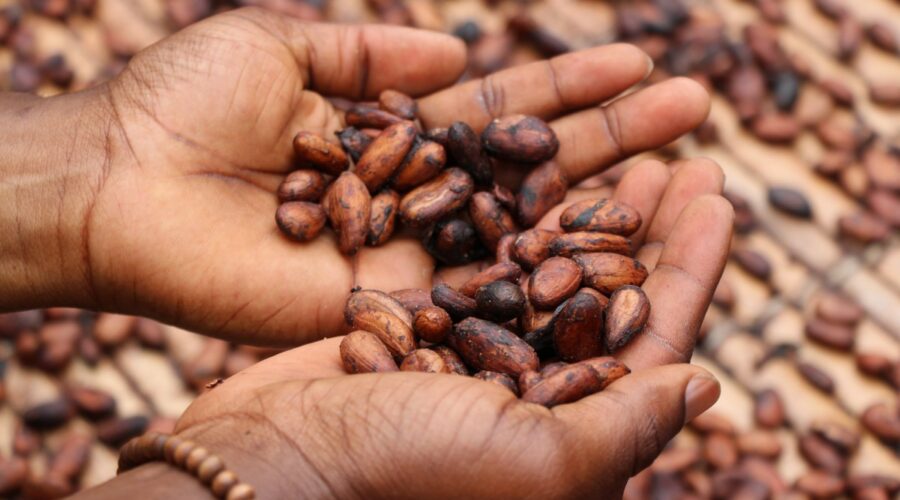Related Files: Supporting Smallholder Farmers for a Sustainable Cocoa Sector June 2020_0
If you’ve had a piece of chocolate recently, there is a good chance the cocoa was grown in West Africa, most likely in Ghana or Côte d’Ivoire. The region produces over 80 percent of the world’s cocoa, which is farmed by nearly 2 million smallholders. [1]
Yet, the rapid evolution of the cocoa sector in past decades with limited transparency, institutional oversight, and increasing global demand – paired with the onset of climate change and cocoa disease – has come at a great cost to the natural ecosystems in the region. Unsustainable production practices run the risk of further depleting their natural capital and pushing them to the brink of ecological collapse. Ghana and Côte d’Ivoire have already lost 17 percent and 20 percent of their forest cover since 2000, respectively, and their deforestation rates continue to present an upwards trend. [2]
The sector is dominated by a handful of multinational corporations, which exert significant influence through their price policies, but also through their supply chain and sustainability programs, and by influencing governments that have a mixed history when it comes to the promotion of sustainable cocoa practices and forest protection. [3], [4] Which farmers get support from these private and public sector actors, and how and when they receive this support, can make a big difference when it comes to achieving sustainability outcomes. This is a main message of our recently published research.
New research focuses on farmers
As a part of the collective effort of the Supply Chain Sustainability Research Fund, our team at Climate Focus led one of four research projects exploring the conditions under which sustainability initiatives encourage better agricultural practices, and the “factors influencing effectiveness.” Specifically, our research aimed to contribute to the effectiveness of company programs in the cocoa sector in Côte d’Ivoire and Ghana through the identification of factors that shift farmer behavior.
We conducted surveys in order to find out what factors determine the uptake of sustainable practices, understood through the lens of climate-smart agriculture (CSA). CSA’s key pillars relate to increasing farm income and productivity, mitigating of greenhouse gas (GHG) emissions, and adapting to climate change. We asked over 400 farmers in high-risk forest regions in Ghana and Côte d’Ivoire questions about their farm characteristics (e.g., size of the farm, productivity), demographic attributes (e.g., gender, education, resident status), legal and institutional aspects (e.g., land tenure, access to credit), forms of support (e.g., cooperatives, companies, or NGOs), specific farming practices, and so on.
Our findings contribute to strengthening the evidence base to inform robust, well-designed policies, interventions, and support programs that target farmers’ actual needs. We found that:
1. Sustainability requires a system-wide overhaul rather than solely an increase in productivity
Cocoa farmers are living in extreme poverty, with significant health and nutrition challenges. Improving their livelihoods (e.g. access to clean water, clinics, and food security) is essential to addressing sustainability concerns. Beyond support programs, it is essential to pay farmers fairer cocoa prices. Without this, farmers will be trapped in a cycle of poverty, and further marginalized. These are the farmers that are most vulnerable to climate change risks; as such, support for planning and research to enhance the resilience of the sector and adaptation capabilities are also necessary. Developing a comprehensive investment compact to overcome structural poverty and ensure longevity is crucial.
2. Supporting cocoa farmers has a positive impact on their productivity
We found that support in the form of training and farm inputs has a clear effect on optimizing cocoa yields. In addition, weak or lacking tenure are both a source of tension and a barrier to conservation. The role of land titles has different implications for farmers’ assets, stability, and readiness to adopt CSA in Ghana and Côte d’Ivoire. In our sample, holding customary or formal tenure rights had a positive effect on increasing productivity. Furthermore, finance is a vital enabler – both farmers with access to credit and farmers who borrow are more likely to adopt CSA practices.
3. There is a need to target resources to younger farmers, female-headed farms, and migrants
Support packages should be tailored to the specific needs of farmers. For example, more attention should be paid to younger farmers, who are more likely to apply learned skills and new practices. Similarly, we observed that female farmers are interested in adopting new practices and attending trainings, but were faced with higher upfront costs. In turn, the barriers female farmers face exert a negative impact on their production. Finally, migrants have less or no access to land titles, which makes them vulnerable, can push them towards the forest frontier, and contribute to deforestation.
What next?
Well-designed initiatives alone will not guarantee successful sustainability or conservation outcomes. Recognizing and incorporating context into sustainability thinking and addressing structural issues are paramount. The effects of influential exogenous pressures on land and power structures beyond the farmer and company control – like climate change, cocoa pests and disease, and the government-controlled institutional and regulatory environment – should be mapped and accounted for.
From a research agenda’s perspective, there is a need for further research on the psychological factors surrounding behavioral change and farmer decision-making, including at different temporal scales. In addition, while this research addressed the factors that enable the implementation of sustainable practices, further research should address directly the relationship between the adoption of these practices and deforestation dynamics in the region.
Companies and governments continue making pledges to address the adverse environmental impacts that emerge along their supply chains, turning to tools such as standards and certification systems to drive change on the ground, based on the assumption that these instruments will lead to long-term conservation outcomes if implemented appropriately. However, the process of going from upstream, high-level pledges to downstream changes in production practices continues to face difficulties around traceability and operationalization, attribution, and evaluation and monitoring. The “right” way to implement activity and engage smallholders, whether it be a code of conduct or capacity-building program, may look very different depending on the commodity or context.
So, where do we go from here? What do these findings mean for sustainable supply chains more broadly? What cross-cutting insights need to be considered when planning and designing for positive change? Stay tuned – we’ll reflect on these questions and more in the coming weeks!
For more information, please see our report, Supporting Smallholder Farmers for a Sustainable Cocoa Sector: Exploring the Motivations and Role of Farmers in the Effective Implementation of Supply Chain Sustainability in Ghana and Côte d’Ivoire (June 2020).
Footnotes:
[1] ICCO Quarterly Bulletin of Cocoa Statistics, Vol. XLV, No.3, Cocoa year 2018/19 (International Cocoa Organization) https://www.icco.org/about-us/icco-news/408- may-2019-quarterly-bulletin-of-cocoa-statistics.html
[2] Weisse, M., & Dow Goldman, E. (2019). The World Lost a Belgium-sized Area of Primary Rainforests Last Year. World Resources Institute. https://bit.ly/2GwEWN1. Primary Forest Loss in Indonesia, 2002-18.
[3] Ruf, F., Schroth, G., & Doffangui, K. (2015). Climate change, cocoa migrations and deforestation in West Africa: What does the past tell us about the future? Sustainability Science, 10, 101–111.
[4] Wessel, M., Quist-Wessel, P., & Foluke, M. (2015). Cocoa production in West Africa, a review and analysis of recent developments. NJAS – Wageningen Journal of Life Sciences, 74–75, 1–7.


